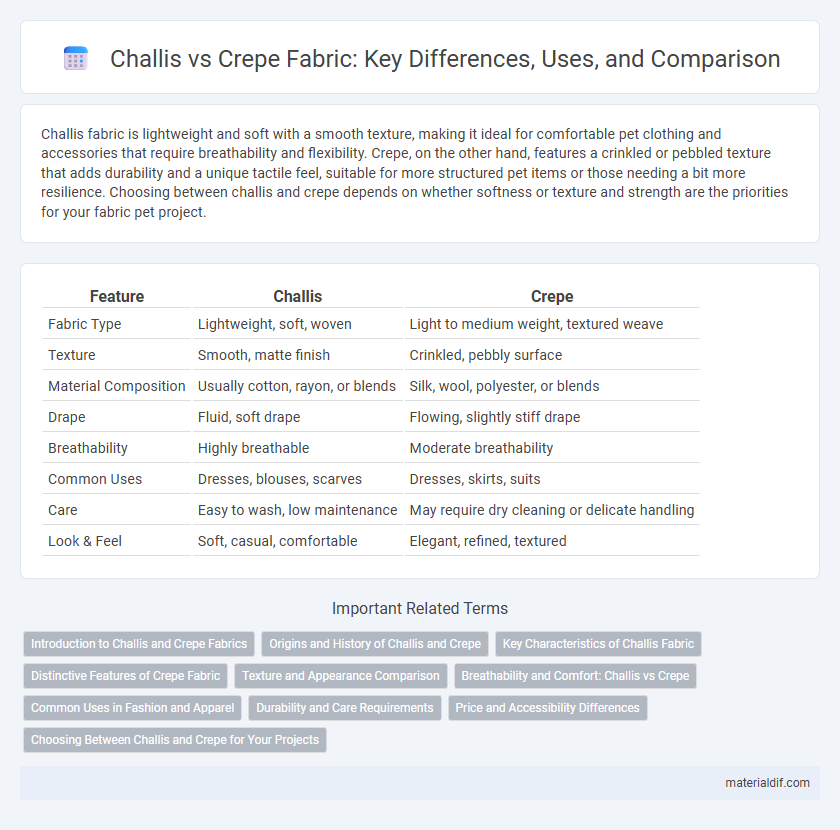Challis fabric is lightweight and soft with a smooth texture, making it ideal for comfortable pet clothing and accessories that require breathability and flexibility. Crepe, on the other hand, features a crinkled or pebbled texture that adds durability and a unique tactile feel, suitable for more structured pet items or those needing a bit more resilience. Choosing between challis and crepe depends on whether softness or texture and strength are the priorities for your fabric pet project.
Table of Comparison
| Feature | Challis | Crepe |
|---|---|---|
| Fabric Type | Lightweight, soft, woven | Light to medium weight, textured weave |
| Texture | Smooth, matte finish | Crinkled, pebbly surface |
| Material Composition | Usually cotton, rayon, or blends | Silk, wool, polyester, or blends |
| Drape | Fluid, soft drape | Flowing, slightly stiff drape |
| Breathability | Highly breathable | Moderate breathability |
| Common Uses | Dresses, blouses, scarves | Dresses, skirts, suits |
| Care | Easy to wash, low maintenance | May require dry cleaning or delicate handling |
| Look & Feel | Soft, casual, comfortable | Elegant, refined, textured |
Introduction to Challis and Crepe Fabrics
Challis fabric is a lightweight, soft, and breathable material typically made from wool, cotton, or rayon, favored for its smooth texture and fluid drape ideal for dresses and blouses. Crepe fabric, characterized by its distinctive crinkled or pebbled surface, is crafted from silk, wool, or synthetic fibers, offering a slightly heavier weight and excellent wrinkle resistance suited for formalwear and suits. Both fabrics provide unique tactile qualities and appearance, with challis delivering comfort and flow, while crepe ensures structure and elegance.
Origins and History of Challis and Crepe
Challis fabric originated in Norwich, England, in the early 19th century, initially created as a soft, lightweight wool or wool-cotton blend ideal for women's dresses and shawls. Crepe traces its origins to the French word "crepe," with historical roots dating back to the Middle Ages, evolving into a silk-based fabric characterized by its crinkled texture used in mourning clothes and formalwear. Both fabrics have distinct cultural and textile heritages, with challis known for its smooth, matte finish and crepe for its textured, puckered surface.
Key Characteristics of Challis Fabric
Challis fabric is lightweight, soft, and breathable, often made from cotton, wool, or blends, making it ideal for warm weather clothing. It features a smooth, matte finish with a slightly brushed surface providing a comfortable drape and gentle texture. Unlike crepe, challis lacks the distinctive crinkled or puckered effect, offering a more fluid, flexible fabric suitable for dresses, blouses, and scarves.
Distinctive Features of Crepe Fabric
Crepe fabric is characterized by its distinctive crinkled or pebbled texture, created through a specific weaving technique using tightly twisted yarns. This texture gives crepe fabrics a slightly rough feel and a matte finish, setting it apart from the smooth, lightweight, and soft qualities of challis. Known for excellent drape and resilience, crepe is often favored in formal wear and garments requiring structure with fluid movement.
Texture and Appearance Comparison
Challis fabric features a soft, smooth texture with a lightweight, flowing drape ideal for dresses and blouses, offering a matte finish that enhances subtle patterns. In contrast, crepe fabric exhibits a distinctive crinkled or pebbled texture with a slightly rough surface, providing greater structure and a lustrous, elegant appearance. The visual difference lies in challis's smooth, matte look versus crepe's textured, shiny finish, influencing garment style and formality.
Breathability and Comfort: Challis vs Crepe
Challis fabric is known for its exceptional breathability and lightweight softness, making it ideal for warm weather and comfortable everyday wear. Crepe, while also lightweight, offers a slightly textured surface with moderate breathability, providing a balance between durability and comfort. For those seeking maximum airflow and a soft drape, challis outperforms crepe in breathability and overall comfort.
Common Uses in Fashion and Apparel
Challis fabric is commonly used for lightweight dresses, blouses, and scarves due to its soft texture and breathable nature, making it ideal for casual and warm-weather clothing. Crepe fabric, known for its distinctive textured surface and drape, is favored in evening wear, suits, and formal dresses for its elegant appearance and durability. Both fabrics offer versatility in fashion but are distinguished by challis's comfort and crepe's refined structure.
Durability and Care Requirements
Challis fabric, known for its lightweight and soft texture, offers moderate durability but may require gentle washing and careful handling to prevent pilling or stretching. Crepe fabric stands out for its excellent durability, retaining texture and shape through frequent wear and washing, often needing dry cleaning or low-temperature machine cycles to preserve its quality. Care requirements for crepe are generally more stringent but ensure longer-lasting fabric integrity compared to the more delicate and high-maintenance challis.
Price and Accessibility Differences
Challis fabric is generally more affordable and widely accessible than crepe due to its lighter weight and simpler manufacturing process. Crepe often commands a higher price point because of its textured surface and the specialized techniques required for production. Both fabrics are available in various blends, but challis remains a budget-friendly choice in most fabric stores and online marketplaces.
Choosing Between Challis and Crepe for Your Projects
Challis offers a lightweight, soft texture ideal for flowing dresses and scarves, providing excellent breathability and drape. Crepe features a distinctive crinkled surface with a slightly heavier weight, making it perfect for structured garments and elegant evening wear. Selecting between challis and crepe depends on the desired fabric softness, drape, and project requirements for durability and appearance.
challis vs crepe Infographic

 materialdif.com
materialdif.com